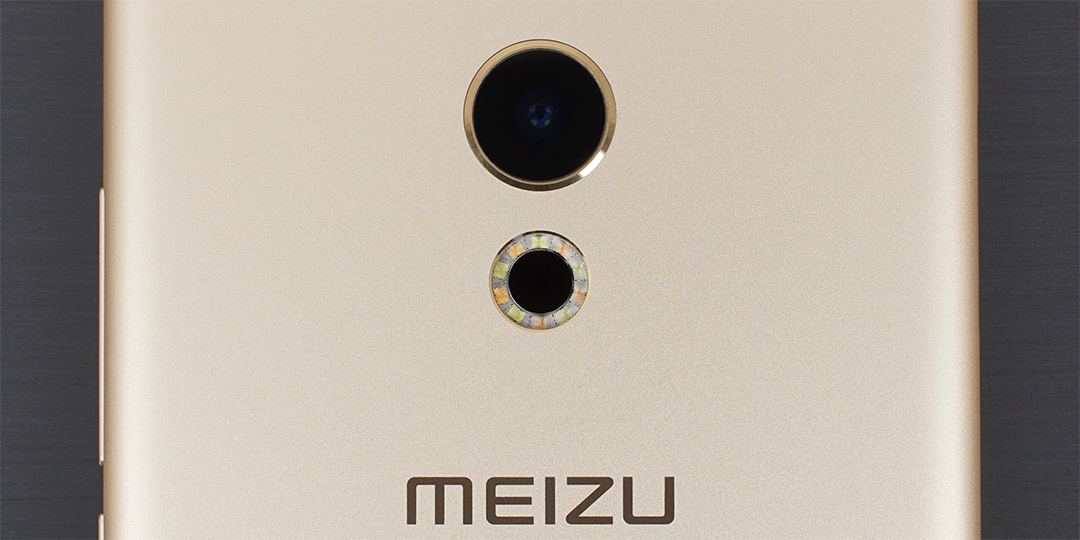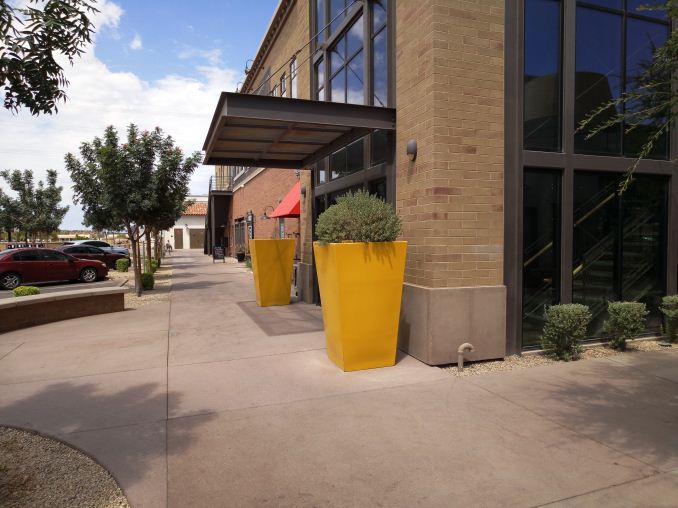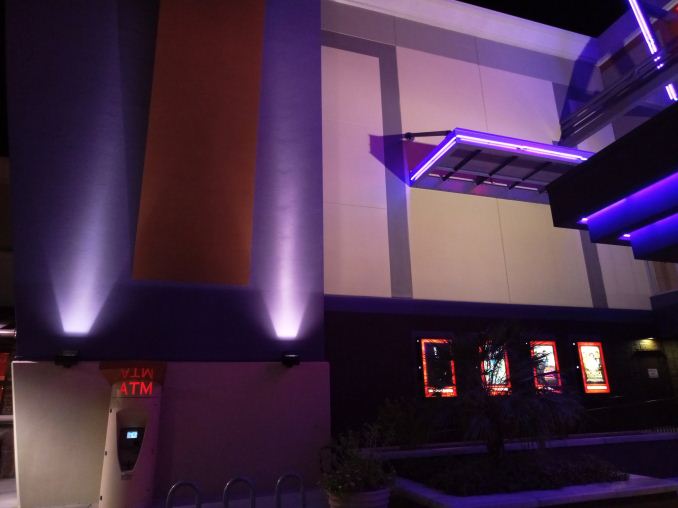The Meizu PRO 6 Review
by Matt Humrick on August 26, 2016 8:00 AM EST- Posted in
- Smartphones
- Mobile
- MediaTek
- Meizu
- PRO 6
Camera Hardware
The Meizu PRO 6 uses the same Sony IMX230 Exmor RS sensor for its rear camera as the PRO 5 that captures up to 21MP images with a 4:3 aspect ratio. This is a backside-illuminated (BSI) CMOS sensor with a stacked design that moves the transistors from the photoactive layer onto one or more separate layers. It does not have deep trench isolation (DTI) technology, however.
There’s no optical image stabilization (OIS) for the rear camera, but it does use a sophisticated hybrid autofocus (AF) system. Like the PRO 5, it combines three different AF technologies with complementary strengths. In good lighting conditions, the PRO 6 can use phase detect autofocus (PDAF) for improved speed. In low-light or low-contrast conditions, it turns to its laser AF module located in the center of the ring flash. This time-of-flight ranging module is STMicroelectronics’ second-generation VL53L0 sensor that improves operational distance to 2 meters (~6.5 feet), about 4x further than the PRO 5’s effective 0.5 meter (~1.6 feet) range. If neither of these solutions prove effective, the PRO 6 falls back to traditional contrast-based AF.
| Camera Architecture | ||
| Meizu PRO 6 | Meizu PRO 5 | |
| Front Camera: Resolution | 5MP | 5MP |
| Front Camera: Sensor | OmniVision OV5695 (1.4μm, 1/4") |
OmniVision OV5670 (1.12µm, 1/5") |
| Front Camera: Focal Length | 2.93mm (28mm equivalent) | 2.64mm (27mm equivalent) |
| Front Camera: Aperture | f/2.0 | f/2.0 |
| Rear Camera: Resolution | 21.16MP | 21.16MP |
| Rear Camera: Sensor | Sony IMX230 Exmor RS (1.12µm, 1/2.4") |
Sony IMX230 Exmor RS (1.12µm, 1/2.4") |
| Rear Camera: Focal Length | 4.03mm (23mm equivalent) | 4.73mm (27mm equivalent) |
| Rear Camera: Aperture | f/2.2 | f/2.2 |
Meizu redesigned the PRO 6’s 6-element lens system to use a shorter 23mm (35mm equivalent) focal length so it could reduce the thickness of the chassis without creating a large camera bump. A shorter focal length increases field of view (how much of a scene fits into a frame) but decreases magnification (focal lengths less than about 50mm produce images that appear smaller than what’s seen with the naked eye). The PRO 6’s focal length is a bit shorter than usual; most rear cameras fall between 26mm (Galaxy S7) and 29mm (LG G5).
Unfortunately, combining the PRO 5’s f/2.2 aperture with a shorter focal length reduces the PRO 6’s aperture area, which means less light reaching the camera sensor. The PRO 6’s aperture area is 27% smaller than the PRO 5’s, a significant reduction that will impact low-light performance. For reference, the PRO 6 also has a smaller aperture area than the Samsung Galaxy S7 (46%), Huawei P9 (20%), and even the iPhone 6s (6%). This gives the PRO 6 the smallest aperture area of any flagship phone (and even most midrange phones) that I’m aware of—a clear case of form over function.
Camera Still Image Quality
A new lens system is not the only camera difference between the PRO 6 and the PRO 5: The PRO 6 uses a different ISP, which means different software post-processing. To see what impact these changes have on image quality, we’ll compare several photos taken with the PRO 6 to the same ones taken with the PRO 5. We’ll also throw in the Samsung Galaxy S7, which uses a 12MP Sony IMX260 Exmor RS sensor with OIS, and the Huawei P9, which uses dual 12MP sensors—one color and one black and white, as additional reference points. All of these phones capture images with a 4:3 aspect ratio, and all of the images were taken using the stock camera app's Auto mode unless noted.
| Daylight Photo Comparison 1 |
In this first daylight scene, I’d say the Meizu PRO 5 actually captures the best image: exposure is perfect, colors are nicely saturated, noise is low, and white balance is very close. The Galaxy S7 and Huawei P9 also get the exposure right, but the S7’s colors are oversaturated and the P9’s white balance is too warm, giving the sky a purple tint. The PRO 6’s image is pretty good too, just not as good as the PRO 5’s. Areas in shadow appear darker and the white clouds are clipped, making them appear overexposed; however, the PRO 6’s shutter speed is almost the same as the PRO 5’s. The difference is that the PRO 6 sets ISO 3x higher, reducing dynamic range.
The PRO 6’s image also shows more noise grain in the sky than the other phones and is definitely using different noise reduction processing than the PRO 5. It’s also using a more aggressive unsharp mask filter than the PRO 5 that makes the grass and bushes look less natural. Both the Galaxy S7 and Huawei P9 also apply heavy sharpening, as indicated by the white halos around the fence, but avoid applying artifacts to the grass and foliage.
These images also show the effect of the PRO 6’s shorter focal length. Even though all of the images were taken from the exact same spot, objects in the PRO 6’s image appear farther away and its camera captures a wider field of view.
| Daylight Photo Comparison 2 |
The images in this second daylight scene show some variation in brightness and color temperature due to small differences in cloud cover, so we’ll focus on detail and post-processing. The PRO 6 captures a nicely detailed image with more texture on the sidewalk and the bricks on the building by combining a high-resolution sensor with less aggressive noise reduction. It does show more noise grain than the other phones again and shows some sharpening artifacts on the sidewalk, though. The Huawei P9 also captures a lot of detail here. Noise reduction processing wipes away some of the background texture from the Galaxy S7’s and PRO 5’s images.
Like most phones, the PRO 6 does not provide a live preview of the HDR effect. Its image capture performance is also slower than similarly priced phones. The PRO 6 takes roughly 1.0-1.5 seconds to capture a standard 21MP image and 2.5-3.0 seconds to capture HDR images at max resolution. For comparison, the PRO 5, which uses the Exynos 7420’s dual-channel ISP, takes up to 2 seconds per HDR shot, which might not sound like much of a difference, but it’s noticeable.
The good news is that the PRO 6’s HDR image quality is much better than the PRO 5’s. Where the PRO 5 just brightens the entire image, making the overexposed areas worse, the PRO 6 effectively brightens the darker areas while reducing the clipping in the brighter areas such as the clouds in the first image. If speed is not a priority, it’s probably a good idea to just leave HDR toggled on, because the PRO 6 consistently sets ISO higher than the PRO 5 and other phones to the detriment of dynamic range. In both of the pictures with HDR turned off, the PRO 6 struggles with shadow detail and clips bright highlights, a problem the PRO 5 does not have with the same camera sensor.
Color saturation also looks much better in the PRO 6’s HDR images, a vast improvement over the PRO 5’s heavily saturated, unnatural colors. There’s some odd ghosting in the tree branches in the first image, but it’s not too distracting and it does not show any noticeable purple fringing that can result from post-processing.
| Evening Photo Comparison 1 |
The Galaxy S7 captures the best image of the movie theater. It sets exposure correctly, and its colors are accurate and nicely saturated. Using the lowest ISO setting of the group (250) helps it keep image noise low while still preserving the building’s texture. It’s image also shows the highest dynamic range of the group.
Even with an 1104 ISO, the highest of the group, the PRO 6 captures the darkest image. Color is similar to the PRO 5’s image: It’s just a little too purple, although, it’s not nearly as bad as the P9’s image. Using the least amount of noise reduction processing helps the PRO 6 preserve more of the building’s texture, at least relative to the PRO 5, but does give its image the most visible noise grain of the group.
The second set of images of the grassy field dimly lit by yellow sodium lamps just shows the performance gap between the Galaxy S7’s flagship-level camera, which specifically focuses on low-light performance by including features such as a large aperture lens, OIS, and larger pixels, and a midrange-level camera system like what’s included in the PRO 6 and PRO 5.
In good lighting, the PRO 6’s camera does pretty well. Exposure and white balance are usually correct, but its images do not have as much dynamic range as the PRO 5’s, leading to clipped highlights and darker shadows. The PRO 6’s post-processing tends to create sharpening artifacts in grass, foliage, and other busy patterns, and its light use of noise-reduction preserves detail at the expense of more visible noise grain, which is most visible in low-light shots. Its HDR mode works well, creating natural looking images that look far better than the PRO 5’s, although processing speed is a bit slow.






























48 Comments
View All Comments
mczak - Friday, August 26, 2016 - link
The Helio X20/X25 does not compete with SD 820, neither with price nor performance. Nor efficiency (I'd argue that's impossible with planar 20nm). And I don't think it was meant to compete (it also for instance only has lte cat 6 vs cat 12 for the SD 820, not that I think this really makes much of a difference). The SD 650/652 though should be way closer in all relevant categories - price, performance, efficiency, features. (Personally I'd take a SD 650 over a X25 any day, because it appears to be a bit more efficient - I have no idea which one is cheaper though.)serendip - Saturday, August 27, 2016 - link
The X20/X25 is supposed to be Mediatek's flagship SoC but it can barely compete against a cheap low-end chip like the SD650 in the Redmi Note 3. I don't know if it's Meizu's poor kernel tuning configs or if the X20 has a suboptimal 3-cluster setup. To me, that mid range cluster seems redundant when an efficient A53 cluster should be the main processing cluster with fast A72 cores being used for bursty tasks, for a fast race-to-idle.serendip - Saturday, August 27, 2016 - link
The Xiaomi Redmi Note 4 with the X20 was just launched in China. I'd like to see a comparo between an X10 Note 3, SD650 Note 3 and X20 Note 4 - as they're all from the same manufacturer, software and tuning should be similar so any differences would be down to the SoC.colinstu - Friday, August 26, 2016 - link
So mediocre performance and basically the worst battery life. Got it.zodiacfml - Monday, August 29, 2016 - link
LOL. This cracked me up. I don't know why. Maybe there's too many devices coming out there, and we have little time to spend on each mediocre device.Personally, when it comes to actually buying an Android, it should be a Nexus or nothing at all. I can't even accept that Android 7.0 is not coming to Nexus 5 which is still flagship performance to me (I just don't like its battery life though).
TheinsanegamerN - Monday, August 29, 2016 - link
See, thats the thing. Nexus phones have poor battery life. Google needs to enforce something closer to 6-7 hours of SoT, not this 3.5 hour BS theyve been doing.Also, blame qualcomm for the lack of 7.0. They refuse to make GPU drivers for the SD80x line for 7.0.
Daniel Egger - Friday, August 26, 2016 - link
Funny, there're now so many keywords which make me stop reading phone reviews: Usually I manage to get all the way to the ridiculous display size but in this case the CPU is the clear no-go.tipoo - Friday, August 26, 2016 - link
That's a pretty elegant way to do the antenna lines.Meteor2 - Friday, August 26, 2016 - link
I'll be shot down... But I really like the Octane benchmark. Please include it in reviews!Eden-K121D - Friday, August 26, 2016 - link
Great review Matt.Basically yuck phone